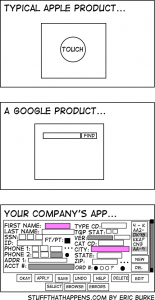Student Posts
- Name: Ye Liu
- Alias: Alex
- Department: Electrical and Computer Engineering
- Direction: Solid State Physics
- Degree: Ph.D. Candidate
- Website (under construction): http://homepages.cae.wisc.edu/~liuy/
- Focus: Major: Micro-Electro-Mechanical Systems(MEMS), especially microfluidics systems and opto-fluidic systems. Using liquid materials to implement optical systems for micro-scale image.
- Interests: Imaging in micro-scales. Design and building opto-fluidic systems for visual data collection in micro-scales. Data analysis and processing for the visual data obtained by actual systems.
- Interest in visualization: I’d consider myself among a “designer” and a “domain scientist”. As my research is interdisciplinary and requires large amount of data and sometimes image, I’d like to learn methods to design my experiments and reports, making them more impressive, efficient, and understandable to others.
- Expectations from this class: Getting basic ideas of information visualization, figuring out more efficient ways to describe and present the result and methodology of my research. Learn some tools and design methodology throughout the class and project.
- Skill set: Have certain skills for programming using C, and some C++. Also familiar with circuit design tool such as Cadance®. Much familiar with physical simulation tool as ANSYS® and Zemax®, which, however, might not be useful in this course.
- Department: Nelson Institute for Environmental Studies
- Program: Environment and Resources
- Degree: Ph.D.
- Website: http://punkish.org
- Focus: Information accessibility and innovation in science.
- Interests: Information policy, information accessibility, semantic web, intellectual property, large scale and long term data management
- Interest in visualization: Stems from interest in large scale data management. I also have a deep interest in design and philosophy of design. I see myself as a “designer.” I believe that design is not how things look but how things work. When things work well, they also look good, and things that look good usually indicate that thought has gone into how they work as well. Unfortunately, this is not always true. My favorite architect (Frank Lloyd Wright) was infamous for not caring how well his buildings worked. Am a fan of Paul Rand, Dieter Rams and the “Apple Computer/Jonathan Ive/Steve Jobs” troika. I love good typography.
- Expectations from this class: Grounding in the academic principles of design, and an opportunity to practice via a substantive class project.
- Skill set: Can program fairly well in Perl and JavaScript. Am quite smitten by Processing.
- Examples that guide: the following
- Dieter Rams’ ten principles of good design (In “Dieter Rams/Selector for 25/25”. http://designmuseum.org/design/dieter-rams)
- Good design is innovative.
- Good design makes a product useful.
- Good design is aesthetic.
- Good design makes a product understandable.
- Good design is unobtrusive.
- Good design is honest.
- Good design is long-lasting.
- Good design is thorough down to the last detail.
- Good design is environmentally friendly.
- Good design is as little design as possible.
- Steve Jobs on design:
- “Most people make the mistake of thinking design is what it looks like… People think it’s this veneer — that the designers are handed this box and told, ‘Make it look good!’ That’s not what we think design is. It’s not just what it looks like and feels like. Design is how it works.” (In “The Guts of a New Machine.” 2003. New York Times. http://bit.ly/5VhU9w)
- “It’s really hard to design products by focus groups. A lot of times, people don’t know what they want until you show it to them.” (In “Steve Jobs: ‘There’s Sanity Returning'”. 1998. Business Week. http://bit.ly/7MayTm)

- Dieter Rams’ ten principles of good design (In “Dieter Rams/Selector for 25/25”. http://designmuseum.org/design/dieter-rams)